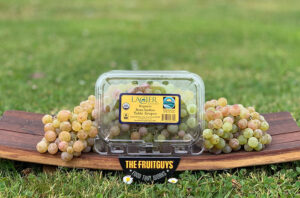The Tale of the Bronx Grape
- By The FruitGuys
- Reading Time: 4 mins.
What’s the best table grape you’ve ever eaten? We think it will be replaced by the organic Bronx seedless table grape from Lagier Ranches in Escalon, CA. These tiny globes of pleasure have been nicknamed the “Rolls Royce of table grapes” for their sweet and smooth taste.

“The bunches are solid and robust, the flavor is out of this world, and the juiciness is enough to make Welch’s jealous!” writes Antonio Wothe, The FruitGuys lead buyer in the San Francisco Bay Area. This artisan grape is so rare that it is included in Slow Food International’s Ark of Taste registry, a global catalog of endangered heritage foods.
Rare and Delicious
No less a culinary authority than Alice Waters called them “mind-blowingly delicious” in her book The Art of Simple Food. And food writer Florence Fabricant of The New York Times described Bronx seedless grapes as “lovely translucent pale green-to-pink grapes (with thin skins and a lush, almost candied flavor).”
The tale of the Bronx Grape is also the story of the agricultural shift that occurred during the last century from delicate artisanal fruit hybrids that tasted amazing and were eaten only locally, to fruit varieties that can endure shipping and have good shelf-life but have a mediocre taste. Sampling a standard supermarket table grape and a Bronx grape will convince your mouth that the old way tasted better.
Thriving in California
This small-batch grown, hybrid table grape is a cross between the seedless Thompson variety and the Concord grape. Its origins date back to 1919, when a grape breeding program was launched between Cornell University’s Agricultural Experiment Station in Geneva, NY and the New York Botanical Gardens in the Bronx, NY to develop a seedless table grape.
The original Bronx seedless grape cross was created in 1925, but was deemed a failure as the berries were prone to fungal infections, skin cracking, and cold damage from the wet and freezing weather in upstate New York. The skin was so thin that the grape couldn’t be shipped commercially because it damaged too easily, ending its 20th Century dreams of cross-country fame.
“Luckily for us though, they are grown just a bit across the San Francisco Bay by a fearless farmer by the name of John Lagier. He is actually the only commercial grower that offers the Bronx!” says Antonio. “Another fun fact that makes me go bananas is that his grapes are grown from a cutting of the original mother vine!”
Lagier Ranch
John Lagier brought the Bronx grape to California in 1979. Today his 120-acre, family-run farm in Escalon, CA is the only producer growing from cuttings of the original Bronx grapevines.
“If I followed what the industry was doing, I’d select only the thickest-skinned grapes that hold a shape and a profit, but no aroma, no flavor, no juice. But that’s not why I grow food. It’s got to taste good. Otherwise, what’s the point?” Says John.
The FruitGuys has been working with John and his wife Casey Havre for 10 years, bringing their table grapes, citrus, and cherries to office customers everywhere.
Casey tells The FruitGuys that as far as she knows, they are the only commercial grower of Bronx grapes in the country. “They never became commercially viable [elsewhere] because they are so delicate. That’s why we pack them in clamshells.”
Organic Harvest box customers in California get a taste of the Bronx grapes in their mixes each year when they are available for a couple of precious weeks in late August to early September. Bronx grapes can only be found through The FruitGuys, the Ferry Building Farmers Market, and speciality shops in San Francisco. They are also flown in to select shops in New York and Connecticut.
Lagier Ranches is also a pioneer in bringing native hedgerows to their corner of the dusty central valley. They started the Hedgegrow Project with the help of a 2014 grant from The FruitGuys Community Fund, the non-profit arm of our GoodWorks program that provides agricultural sustainability grants to small farms.
They received a $2,500 grant to install pollinator hedgerows along the border of a newly planted 39-acre almond orchard. The hedgerow attracts pollinators such as bees, butterflies, moths, and hummingbirds, and provides shelter for ground-nesting bees and other beneficial creatures. There is a renewed interest and enthusiasm for California native plants due to their drought resistance and ability to provide food for our native pollinators.
“Our job is to leave it better than we found it,” Casey told The FruitGuys Magazine in 2016. “So if it’s through farming or improving it with sustainable practices with the hedgerows, then that’s my job. Prettier, more fertile, more abundant with animals and bugs. To leave it better.”
Antonio says John and Casey are prime examples of the kind of trend-bucking farmers The FruitGuys treasure.
Antonio Wothe, The FruitGuys South San Francisco Buyer, contributed to this report.


